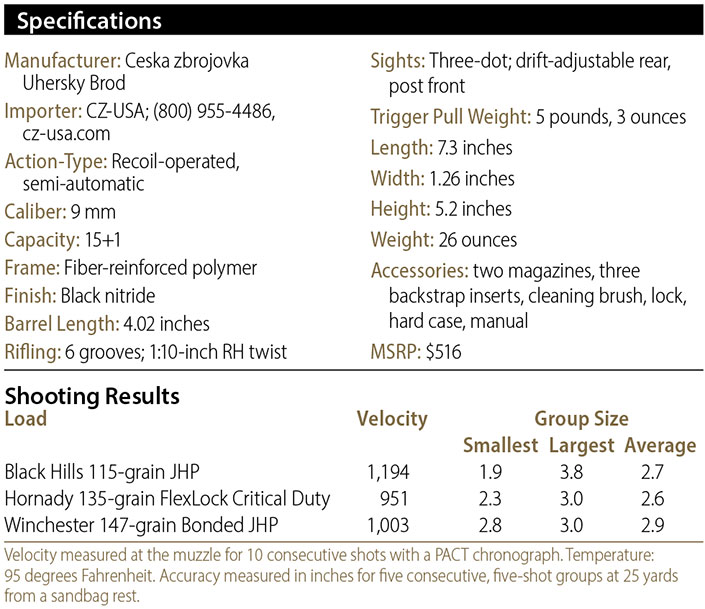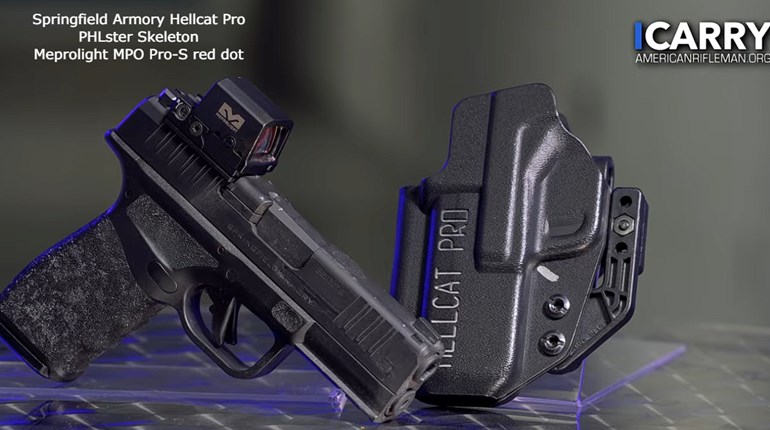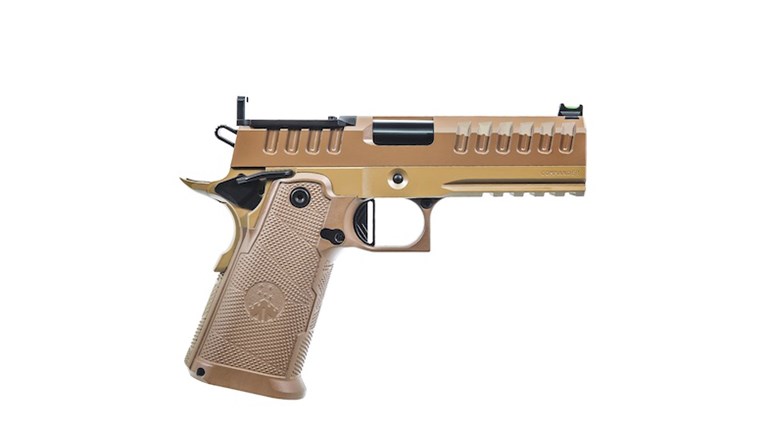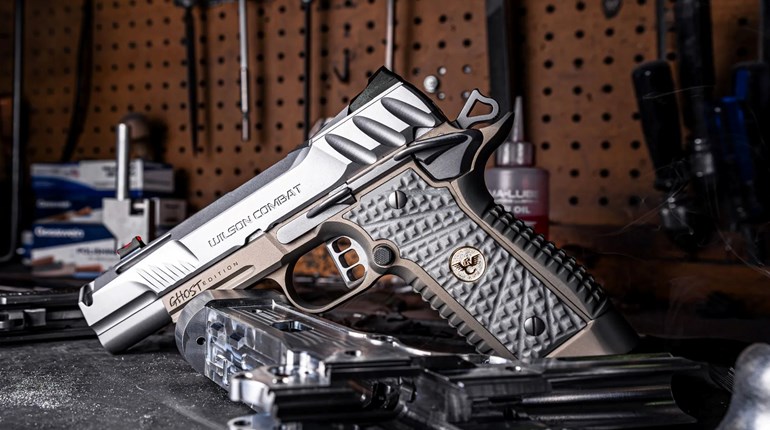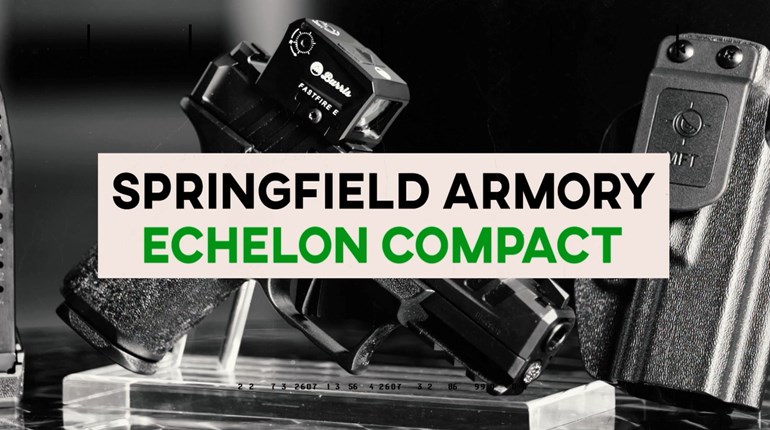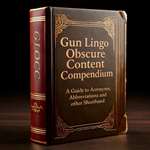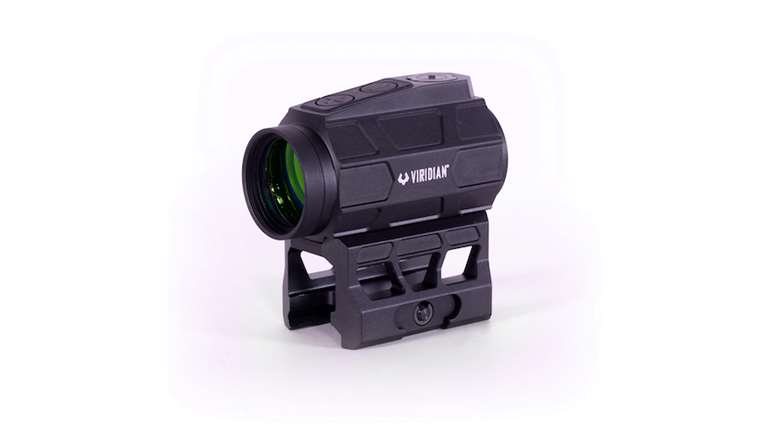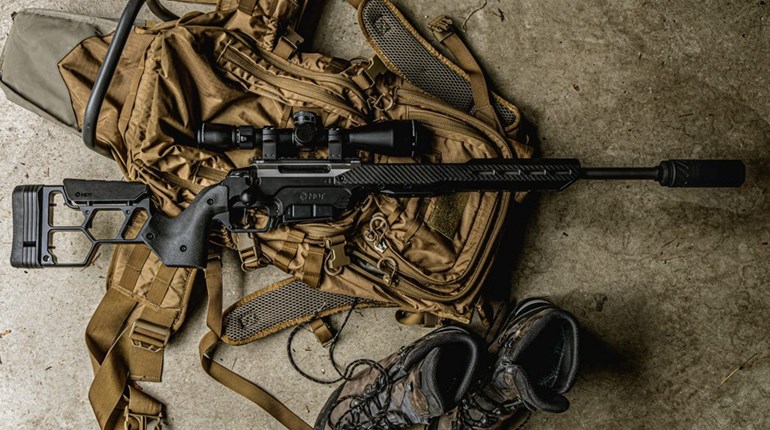
The CZ P-10 C pistol shown above from CZ-USA is the company's first-ever polymer-frame, striker-fired handgun, joining a market that offers a range of options in the striker-fired genre and giving consumers more choices than ever before.
When the polymer-frame, striker-fired semi-automatic pistol first hit the firearm market, there was a slew of handgunners, myself included, who simply shook their heads and figured it was just another passing trend. Firearms, particularly handguns, just weren’t worth their salt unless they were built of blue, carbon steel and wood, and nice wood at that.
When certain polymer-frame handguns began to virtually take over the law enforcement sidearm market in the United States, handgunners, including yours truly, certainly took notice. As anyone familiar with handguns might be aware, polymer pistols now dominate the handgun market, and there’s a good reason for that.
It took me a great deal of shooting and experimentation to warm up to the idea of a polymer-frame, striker-fired pistol, but I did, indeed, finally see the light. I’ve carried a number of them, and have come to rely on them a great deal. After conducting a number of reviews of various brands and styles of such pistols, I’ve come to respect them much more than I ever imagined.
CZ-USA has been manufacturing, importing and distributing high-quality firearms for may years, and has certainly become one of the most-respected names in the firearm business. I’ve fired many of their offerings, and have yet to be disappointed by any of them.
When the company decided to break into the polymer, striker-fired handgun market with the CZ P-10 C, the engineers knew they didn’t want just another, run-of-the-mill plastic pistol along the lines of so many other manufacturers. They were looking for a gun that fit the needs of the real, everyday shooter, along with military and law enforcement personnel. This would entail building a pistol that would be extremely durable and accurate, and one that would fit well in the hands of anyone who tried it.
The result is the CZ P-10 C.
Upon opening the CZ P-10 C box for the first time, I must admit I wasn’t taken aback by any specific feelings of longing. It seemed to me just another of this new breed of pistol. There are many of them, and many look very much the same. Black steel, plastic grip frame, well, you get the picture.

Any feelings of angst came to an abrupt halt when I took the gun out of its case. One of my pet peeves when it comes to a handgun has always been fit and feel in the hand. The finest, most expensive handgun in the world is useless to me unless it fits. If it fits my hand well, it speaks to me. The CZ P-10 C spoke. This is exactly what the folks at CZ intended to happen, not just with me, but every shooter who picks up the pistol.
The mechanical configuration and function of the P-10 C is much like other polymer-frame pistols, but with this gun, ergonomics definitely make a difference. Upon grasping it (empty) and assuming a shooting stance, I understood right away what the CZ P-10 C was all about.

Many, but not all, of the polymer pistols I’ve experienced have had a focal point which, in my opinion, was far too high above the pivotal point. In other words, the sights were too far above the top of the hands where the pistol was gripped. For me, and other shooters I know, this gives the pistol a feeling of imbalance and can negatively affect accuracy. This adverse effect in accuracy can, at times, be no fault of the gun whatsoever, but rather the way the shooter grips and fires it. Other polymer pistols can have different ergonomic issues, as well. Some pistols I’ve experimented with and carried have been designed in such a way that natural point shooting can be negatively impacted. I’ve been shooting a handgun a long time, and I’ve been pretty well set in my ways regarding grip and sight picture for a good while. When I grip a handgun, I close my eyes and point at an intended target. When I open my eyes, I want the sight picture to be more or less on target (this is just a training example–I never close my eyes when actually shooting). I’m not even close with some polymer pistols simply because of the grip angle.
CZ’s P-10 C is a different story. I find the grip angle to be almost perfect. It points quite naturally, and the sight picture has a very low axis in the hands. For me, this is a recipe for easy, accurate shooting. A combination of factors contributes to the great fit and feel of the CZ P-10 C. Along with the grip-to-frame angle, the grip itself is a major factor. The outsides of the grip have a slight swell on each side, accompanied by a coarse, square, stippled pattern. A separate pattern adorns the front and back of the grip frame, providing solid purchase all the way around.
The transition from the grip to the top and rear of the frame is made more comfortable by a deep saddle just underneath the rear of the slide. The web of the strong hand fits there very comfortably and this contour places a bit of the gun’s mass over the back of the hand. This gives the pistol a feeling of weight distribution toward the rear rather than the front. Further, another saddle at the top of the front of the grip transitions easily into the trigger guard, providing even more comfort. It should be noted that the CZ P-10 C comes with two extra grip inserts, allowing the shooter to recontour the grip to fit his or her hand. I found the original insert to fit my hand best.
Clearly, the fit and feel of the CZ P-10 C isn’t the only factor in making the pistol what it is. One of the major issues for the CZ engineers in designing the P-10 was the trigger system, or more specifically, how to make the system more efficient and easier to handle.
Many triggers on striker-fired pistols can have a spongy feel. This isn’t the case with the CZ P-10 C. After handling the pistol a good deal, I noticed that the trigger felt as if a gunsmith had worked it over with a light stone. The pull is consistently smooth, with no creaky spots. When the slack is taken in the trigger, the final break is short and crisp with no creep at all. The trigger break on my test gun measured just a hair more than 4.5 pounds on my RCBS trigger pull scale. One of the impressive things about the P-10’s trigger is the unusually short, quick reset, truly making rapid shooting a cinch.

My only complaint about the trigger on my test gun is likely of my own doing. I’ve been handling a handgun virtually all my life and I have my own specific way of placing my index finger on the trigger. The trigger on the P-10 C is designed to be pulled perfectly straight to the rear. My trigger method involves a little lateral movement at times. In doing this with the P-10 C, I found a slight catch at the beginning of the trigger pull. My friend and fellow shooter, Ben Etcheverry, a competitive shooter, didn’t experience this in the least with the CZ P-10 C. After shooting the pistol awhile, I didn’t experience it either.
The CZ P-10 C was definitely built for durability. CZ’s engineers constructed this pistol with strenuous military and police testing in mind. The plastic portion of the pistol is made with fiber-reinforced polymer to withstand the toughest abuse. Its finish is an extremely tough black nitride.
Regarding the pistol’s fire controls, it is fitted with an ambidextrous slide release. The release is serrated and fits flat up against the grip frame and bottom of the slide. While this is great for concealed carry in that it won’t hang up on clothing and whatnot, it is rather difficult to operate and almost takes assistance from the off hand to engage.
This pistol is also fitted with a three-dot sight system so popular on many of today’s handguns. I’ve criticized this sight system for many years now, and personally just don’t like them, for a number of reasons. I have spoken with numerous manufacturers and industry experts about the three-dot system and why it’s so popular, and generally get the same response—“customers love them.” Having said that, I’ve tried to accept them and figure out a way to not criticize them. That being noted, I spent a lot of time shooting the CZ P-10 C, and was able to overlook the sights–no pun intended. The one good thing about the three-dots on the CZ, they aren’t standard, painted-on white dots. After being exposed to a light source, they become night sights, and damn good ones.

Shooting the CZ P-10 C was a pleasing experience. Etcheverry threw in with me to shoot the first couple hundred rounds through the pistol. We both found it to be a comfortable, accurate and fast handling gun. Recoil was minimal, and we both attributed that to the great fit in the hand, plus the grip angle. We shot slow fire, then worked up to rapid fire, shooting at a steel plate at distances from 15 to 25 yards. As with any semi-auto pistol, as the magazine emptied, the recoil was more noticeable, but never uncomfortable.
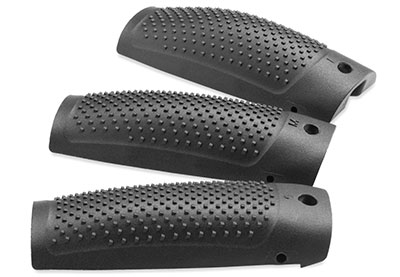
Deep checkering in the grip frame ensured a firm grip at all times during shooting. The pistol functioned perfectly, without a hiccup of any sort, using Black Hills 115-grain JHP.
At the bench, the CZ P-10 C continued to perform well. For accuracy and velocity testing I used three factory loads, including Black Hills 115-grain FMJ, Winchester 147-grain Bonded JHP and Hornady’s 135-grain FlexLock Critical Duty. The tightest group was printed by the Black Hills, at 1 7⁄8 inches, with the largest being also with the Black Hills, at 3 3⁄4. Interestingly, I continued firing after my last five-shot string with the Winchester. Out of 10 shots, it had seven in a sub-2-inch group dead center.
The P-10 C is available in several configurations including the black version, which I tested, an FDE-colored version and a suppressor-ready model. I hope to have the chance, at some point, to experiment with all of them.
The fact that CZ took its time to enter the striker-fired pistol market shouldn’t raise any suspicion with shooters who’ve been using handguns in that format for a long time. I believe the CZ P-10 C was well worth the wait, and I believe shooters will agree. It just fits.

